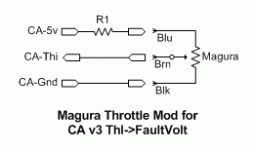Yes. I am presently using the Vaux input to provide three power levels using current limiting (Ctrl->AuxFunct = AmpsLim). I have a little post with an Excel resistor calculator that will go up shortly to illustrate this using an off-the-shelf Crystalyte LMH switch.ashwright said:Can the Aux input be used to control max throttle out?
Justin will need to verify, but it appears that there is mode that will do exactly what you want with Ctrl->AuxFunct = PasLevel. If you check the Setup summary, you can see two other associated parameters (Ctrl->PASMode and Ctrl->AssistLevel) that appear to determine operation at the 100% value for the POT pad (Vaux) on the CA PCB.ashwright said:I am trying to think of a way of using the new CA, to control the performance of a PAS, mid mount bike. So you can use the three way switch on the handle bars to say, Pedestrian mode (10%, 5kph, very slow accell), bike mode (70%, 30kph, medium accell) and road mode (100%, fast accell).
My current bike has a PAS controller, with a three way switch, which seems to have this behaviour. But most newer good controllers don't have this, and it looks like the new CA would be perfect, with a basic, cheap, high performance controller.
Would there be any other way of using the CA in this way?
As with Ctrl->AuxFunct set to any of the other possible control modes, it remains only to use a resistor divider to obtain a couple of lower percentage values of the voltage range Ctrl->MinAuxIn to Ctrl->MaxAuxIn and to select one of these fixed voltages with a switch. One possible configuration might use a SPDT on-off-on switch arranged like this:



